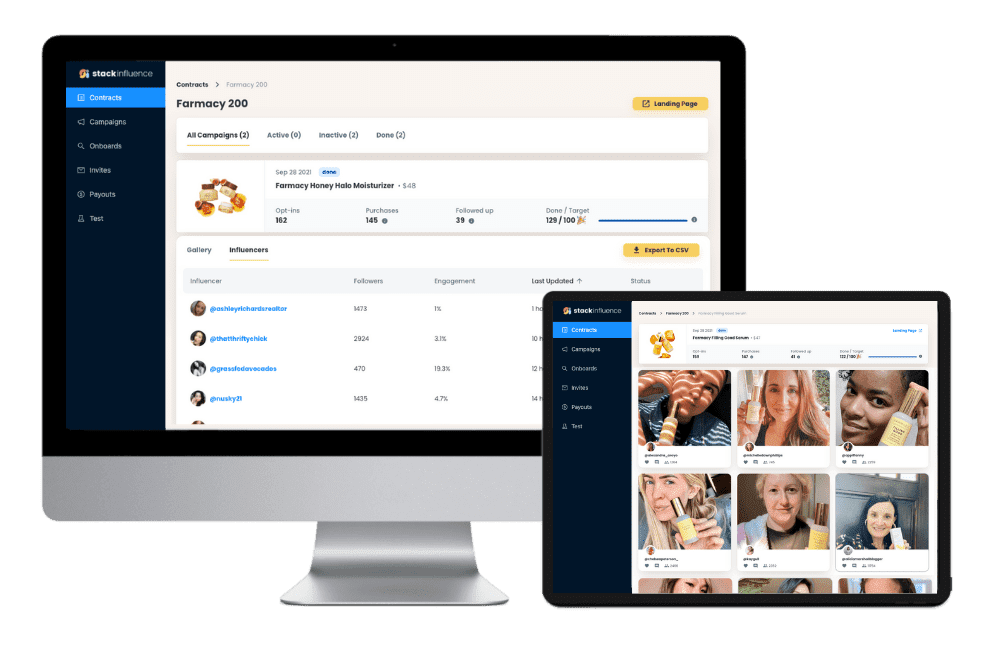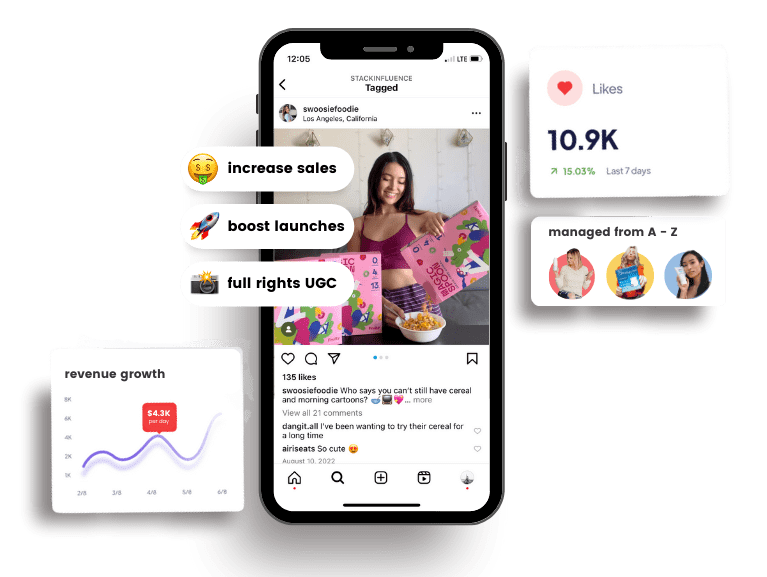Brands That Went Viral on TikTok (and What You Can Learn)
7th
October, 2025
Influencer Marketing
Amazon Marketplace
Artificial Intelligence
TikTok Tips
TikTok isn’t just for dance challenges and lip-syncing teens – it’s become a goldmine for brands and e-commerce sellers. With its algorithm capable of catapulting any video to millions of viewers, TikTok has spawned the “TikTok made me buy it” phenomenon where micro influencers and everyday content creators drive insane sales for products through authentic, catchy videos. From Amazon sellers to legacy companies, everyone has a shot at going viral with the right content and a bit of luck. Below, we highlight five brands that went viral on TikTok and break down how they did it, why it worked, and what e-commerce entrepreneurs (like Amazon sellers) can learn. (Hint: leveraging user-generated content (UGC) and micro influencers is often key.) Let’s dive in!
1. e.l.f. Cosmetics
When e.l.f. (short for eyes lips face) set out to resonate with Gen Z, they went all-in on TikTok with a bold strategy: create a catchy original song and hashtag challenge. The result was #EyesLipsFace, a campaign that became the most viral TikTok challenge in U.S. history. The brand’s 15-second original song (with an infectious beat) inspired users to film quick makeup looks and fun dances. The campaign attracted over 5 million UGC videos from users and totaled around 7 billion views – yes, billion with a “B.” Even celebrities like Lizzo and Reese Witherspoon jumped in for free, amplifying the trend. This explosion of content propelled e.l.f. from being a smaller drugstore makeup name to a favorite among teens, moving it from #8 to #2 in teen beauty brand rankings and driving eight consecutive quarters of sales growth during a tough period for the industry.
Why It Went Viral
e.l.f. nailed the formula of TikTok virality – music + challenge + UGC. By using an original, on-brand song (“Eyes Lips Face”) and a simple challenge, they empowered content creators to participate en masse. The content didn’t feel like an ad; it felt like a fun trend anyone could hop on. Micro influencers and everyday users alike made videos, providing social proof and authentic enthusiasm. Essentially, e.l.f. handed the creative reins to TikTok users, and that user-driven creativity made the campaign explode. The huge view count (see chart below) underscores how a well-executed TikTok campaign can eclipse traditional media reach by orders of magnitude.
TikTok views generated by viral content for each featured brand. e.l.f.’s #EyesLipsFace challenge led with an astonishing ~7 billion views, dwarfing other virals like Stanley’s tumbler (~900M views) or CeraVe’s skincare hype (~825M). Even a 13M-view TikTok (Ocean Spray) can have outsized impact when it captures media attention.
Takeaways for Brands:
- Don’t be afraid to start a trend: A custom song or hashtag (especially one that’s easy to riff on) can ignite massive participation. Encourage UGC – let fans put their own twist on your trend.
- Keep it fun and native: Content that feels organic to TikTok (rather than polished advertising) wins. e.l.f.’s challenge was casual, upbeat, and inclusive, perfectly fitting TikTok’s vibe.
- Leverage micro influencers to seed the campaign: e.l.f. worked with TikTok creators early on. A handful of enthusiastic micro influencers can set the trend in motion by example, then the broader community follows.

Unlock the Power of Micro Influencers and Elevate your Brand Today!

2. Ocean Spray
Sometimes, the most viral brand moment is one money can’t buy. Ocean Spray, the classic cranberry juice company, struck TikTok gold in 2020 thanks to a single, authentic video – not produced by the brand, but by a regular guy on a longboard. In the famous clip, TikToker Nathan Apodaca (aka @Doggface208) skateboards peacefully while swigging Ocean Spray cranberry juice straight from the bottle, all to the tune of Fleetwood Mac’s “Dreams.” The vibe was so pure and chill that the 23-second video blew up during the height of pandemic stress. It racked up over 13 million views on TikTok, and when news outlets picked it up, the exposure went through the roof – Ocean Spray garnered over 2 billion media impressions off this viral moment. The song “Dreams” reentered music charts (streams jumped 374% after the video) and Ocean Spray found itself suddenly trending with Gen Z.
What’s impressive is how Ocean Spray responded. Rather than launch an overly polished ad campaign, the company leaned into authenticity. They thanked Nathan by gifting him a new cranberry-red truck (filled with juice), a gesture that felt humble and human. Later, they even featured him in a casual TikTok-style commercial at fans’ request. By joining the conversation naturally (and not stealing the spotlight from the creator), Ocean Spray endeared themselves to young audiences. The TikTok team itself was so impressed that they created a TV ad compiling Ocean Spray fan videos, highlighting the power of UGC – “It starts with TikTok,” the ad concludes.
Why It Went Viral
This was lightning in a bottle – a completely unplanned, genuine moment that resonated widely. The video wasn’t an ad; it was just real. TikTok’s algorithm loves authentic content, and viewers do too. The carefree skateboarding and nostalgic music created a mood that people craved, and they shared it millions of times. In essence, an ordinary user became a micro influencer overnight, turning a bottle of Ocean Spray into a cultural icon without a single marketing dollar. Ocean Spray’s smart, light-touch engagement with the trend (amplifying it rather than trying to control it) kept the positive vibes rolling.
Takeaways for Brands:
- Authenticity wins: You can’t script the magic of genuine UGC. Be on the lookout – if a creator features your product in a viral hit, amplify their content and show love (don’t rush to impose your corporate agenda).
- Be part of the moment: Ocean Spray’s team advises, “Be part of the moment. Don’t be the moment.” In other words, support what the community is doing instead of making it all about your brand.
- Stay agile and positive: Have a listening ear on social media so you can jump on opportunities. A kind gesture or a fun response can turn goodwill into lasting brand loyalty among viewers.
3. CeraVe

Who would’ve thought an unassuming drugstore skincare brand would become a TikTok superstar? CeraVe, known for its plain packaging and affordable moisturizers, saw its fortunes flip thanks to TikTok skincare influencers (or “skinfluencers”). In 2020, skincare guru Hyram Yarbro (then a micro influencer turned mega influencer) raved about CeraVe’s products in videos, sparking a frenzy. His TikTok followers (in the millions) heaped on praise for CeraVe, and soon the hashtag #CeraVe exploded with views. To date, TikTok posts tagged #CeraVe have amassed roughly 825 million views – far more than many glossier, high-end beauty brands. This surge of peer recommendations and reviews translated into real-world impact: during the summer of 2020, CeraVe products were selling out at stores as teens and young adults snapped them up, and the brand’s parent company reported record growth. In fact, online search interest for CeraVe spiked +359% in June 2020 at the peak of the TikTok hype (versus ~+38% for other skincare brands)kantar.com, signaling a massive wave of new customers discovering the brand.
Crucially, CeraVe didn’t manufacture a TikTok campaign – the community did it for them. The brand benefited from what was essentially free marketing via countless reviews, “skincare routine” videos, and before-and-after skin transformation posts. In a one-year period, CeraVe saw a 70% jump in “earned media value” (a metric for influencer-driven buzz) and doubled the number of content creators talking about itInstead of flashy ads, CeraVe leaned into this organic love by engaging with influencers long-term. They built relationships with dermatologists and content creators who genuinely loved the brand’s no-frills effectiveness, ensuring that the buzz sustained beyond the initial viral moment.
Why It Went Viral
CeraVe’s rise shows the power of trust and community on TikTok. Gen Z viewers are hungry for honest recommendations, and CeraVe hit the sweet spot: effective, affordable, dermatologist-approved. When micro influencers and popular creators (like Hyram) vouched for it, it didn’t feel like an ad – it felt like advice from a friend. The TikTok format of short, relatable video reviews made skincare advice accessible and hype-able. The brand’s authenticity (being cheap and not glitzy actually worked in its favor) made it “cool to be basic” in the eyes of young skincare enthusiasts. Essentially, TikTok word-of-mouth turned CeraVe into a cult favorite without the brand having to spend millions on marketing.
Takeaways for Brands:
- Cultivate influencer advocates: Rather than one-off sponsorships, build genuine relationships with content creators in your niche. CeraVe’s longtime partnerships with skincare influencers gave it consistent, credible mentions. Authentic praise beats any scripted ad.
- Embrace UGC reviews: Encourage happy customers to share their experiences. Reviews, how-tos, or reaction videos can snowball into a trend (especially if you repost or acknowledge user content). Social proof is everything.
- Know your audience’s values: CeraVe won Gen Z by aligning with what they value – transparency, efficacy, and affordability. Highlighting those points (through influencers or your own content) can strike a chord more than a glossy pitch. For e-commerce and Amazon sellers, note that many TikTokers use hashtags like #TikTokMadeMeBuyIt and #AmazonFinds – getting your product into that mix via micro influencer reviews can drive serious sales.
4. Little Moons
Not every TikTok success story belongs to a big brand – TikTok is also a boon for small businesses. Little Moons, a family-run mochi ice cream brand from the UK, is proof that even a tiny company can shoot to stardom with the right viral moment. In early 2021, some TikTok users posted videos of themselves hunting down Little Moons mochi bites in local supermarkets (using the hashtag #LittleMoons). These were casual, even mundane videos – people going to “big Tesco” (a supermarket) and excitedly trying the mochi. But their genuine enthusiasm for the chewy, colorful ice cream bites struck a chord. Within weeks, the trend snowballed to 300 million+ views on TikTok. Little Moons became the must-try snack, and demand went through the roof. Supermarkets across the UK sold out of the product, and in one major chain (Tesco), sales shot up by 1,300% (13×!) thanks to the TikTok craze.
For a small business, this kind of viral surge could be chaotic, but Little Moons was savvy. They already had a TikTok account and had been posting fun content (so they understood the platform’s tone). When the trend took off, they engaged by responding to videos and fanning the flames of excitement. The co-founder noted it was a “perfect storm” – pandemic lockdowns meant people were looking for novelty at the grocery store, and the product itself is visually fun (squishy mochi balls beg to be filmed). By not interfering with the organic trend and instead encouraging fans, Little Moons turned a short-term viral moment into lasting brand awareness. They expanded production to meet demand, and even launched in new countries (riding on the global TikTok buzz). To this day, they credit TikTok for putting them on the map in a way traditional marketing never could.
Why It Went Viral
Little Moons’ virality shows how random discovery and relatability can ignite a brand. The TikTok videos weren’t ads; they were real people sharing a tasty find. The content was simple: “I went to buy this hyped snack, here’s my reaction.” That authenticity, combined with the satisfying visuals of the product (mini ice cream balls that you can stretch and squish), made it perfect TikTok fodder. Importantly, because the product delivered on taste, the hype kept building as more people tried it and posted their own reviews. It was a virtuous cycle of UGC. And unlike a planned campaign, this had the charm of spontaneity – viewers felt like they were in on a secret trend early. Little Moons also benefited from scarcity FOMO (empty shelves made it even more desirable).
Takeaways for Brands:
- Any brand can catch a trend: Even if you’re a small business or Amazon seller, a single viral TikTok review can introduce your product to millions. Make sure you have a presence on TikTok (you never know when someone will mention your brand) and be ready to engage.
- Visual appeal matters: Products that are eye-catching or novel stand out in feeds. Think about what makes your product TikTok-friendly – interesting packaging, a unique use case, satisfying results, etc., and highlight that in content.
- Ride the wave: If you get a sudden influx of interest, capitalize on it. Stock up your inventory if possible, answer questions from curious commenters, and consider light-hearted response videos. Showing that you’re excited along with everyone else reinforces the positive buzz. (Just like Little Moons, don’t oversell – join the party rather than trying to run it.)

Unlock the Power of Micro Influencers and Elevate your Brand Today!

5. Stanley

Perhaps one of the most astounding TikTok success stories is that of Stanley, a heritage brand (founded 1913) known for rugged thermoses and lunchbox gear. For decades, Stanley’s insulated bottles were marketed to campers, hikers, and workers – pretty niche. But in the past couple of years, Stanley became a pop culture phenomenon thanks to an unlikely hero product: the Stanley Quencher tumbler, a large 40oz drink cup with a handle. How did a utilitarian tumbler become a trendy must-have? TikTok. A community of lifestyle and mom micro influencers discovered that the Stanley cup was perfect for iced coffees, workouts, and moms-on-the-go. These women (not affiliated with Stanley initially) raved about the tumbler’s huge capacity and convenience. Their passion spread on TikTok like wildfire, snowballing into a craze. The hashtag #StanleyTumbler now has around 900 million views on TikTok, and the cups became so popular they were constantly selling out online.
The numbers behind Stanley’s comeback are staggering: the company’s annual revenue soared from about $70 million in 2019 to $750 million in 2023, largely on the back of Quencher tumbler sales. At one point, sales of the Quencher line were up 275% year-over-year – an almost unheard-of growth rate for a century-old brand. Stanley embraced this new audience by pivoting its marketing to focus on the lifestyle angle (bright colored tumblers, targeting the Instagram/TikTok aesthetic crowd). They even collaborated with influencers and launched limited-edition colors to stoke excitement. But notably, the core of their viral growth was entirely user-driven content – everyday folks posting “Check out my Stanley cup!” videos. It was the modern word-of-mouth. By leveraging that, Stanley transformed from a dusty outdoor brand to a trendy accessory for the younger demographic.
Why It Went Viral
Stanley’s virality came from listening to its new fans. The product itself was a sleeper hit – it solved a practical need (staying hydrated) but in a stylish way that TikTok’s lifestyle community adored. Once a few micro influencers in the homemaking/fitness niches gave it their stamp of approval, a chain reaction ensued. TikTok’s algorithm boosted videos of people decorating their cups, taking them in the car, and comparing colors – turning the Stanley into an aspirational item. Because all this content was organic and peer-driven, it felt more trustworthy and desirable than any ad. It reached a point where seeing countless others praise the Stanley cup created a bandwagon effect: you had to have one to see what the hype was about. Stanley’s team smartly amplified this by engaging with creators and not being afraid to shift their brand image to align with what consumers were organically showing – that the product isn’t just for camping, it’s for everyday life (and it looks great on camera!).
Takeaways for Brands:
- Social proof is powerful: When you see hundreds of real people loving a product, it creates momentum. Encourage customers to share their experiences on TikTok or Instagram. Repost user stories. Consider working with a network of micro influencers (for instance, via Stack Influence or similar platforms) to seed your product with relevant communities – their genuine excitement can ignite a trend.
- Adapt to new audiences: If a new demographic discovers your product, welcome them! Tailor your marketing to speak their language. Stanley’s pivot to pastel colors and influencer collabs showed they embraced what their new young fans wanted.
- Limited supply + exclusivity: The “sold out” status and special edition drops kept Stanley’s hype high. While you shouldn’t artificially constrain supply to the point of frustrating customers, having phased releases or unique variations (colors, flavors, etc., depending on your product) can keep people talking and coming back to check for restocks.
Conclusion to Brands That Went Viral on TikTok
As these stories show, TikTok can catapult brands to new heights – often unexpectedly. Whether you’re a budding e-commerce brand, an Amazon seller, or a legacy company, there are some common threads to viral success on TikTok and social media at large:
In the age of TikTok and the creator economy, the playing field is more level than ever. Smart brands – no matter their size – are those that engage genuinely with creators and communities. By learning from the examples of e.l.f., Ocean Spray, CeraVe, Little Moons, and Stanley, you can craft your own strategy to harness TikTok’s power. Keep it authentic, embrace the creativity of micro influencers and fans, and your brand might just be the next viral success story that everyone is talking about!

By William Gasner
CMO at Stack Influence
William Gasner is the CMO of Stack Influence, he's a 6X founder, a 7-Figure eCommerce seller, and has been featured in leading publications like Forbes, Business Insider, and Wired for his thoughts on the influencer marketing and eCommerce industries.
Want new articles before they get published? Subscribe to our Awesome Newsletter.
stack up your influence
turning creativity into currency
our headquarters
111 NE 1st St, Miami, FL 33132
our contact info
[email protected]
stack up your influence
turning creativity into currency
our headquarters
111 NE 1st St, 8th Floor
Miami, FL 33132


